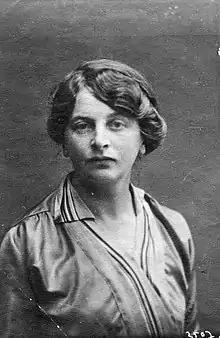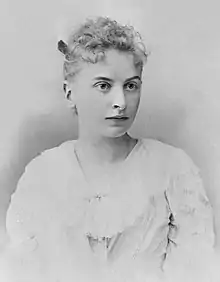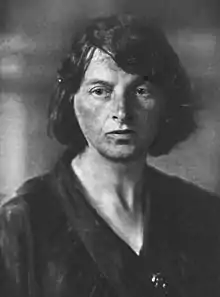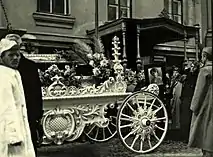Inessa Armand
Inessa Fyodorovna Armand (born Elisabeth-Inès Stéphane d'Herbenville; 8 May 1874 – 24 September 1920) was a French-Russian communist politician, member of the Bolsheviks and a feminist who spent most of her life in Russia.[1][2][3] Armand, being an important figure in pre-Revolution Russian communist movement and early days of the communist era, had been almost forgotten for a long time (due to deliberate Stalinist censorship, partly in consideration of her relationship with Lenin) until the partial opening of Soviet archives during the 1990s (despite this, many valuable sources regarding her life still remain inaccessible in Russian archives).[4] Historian Michael Pearson wrote about her: "She was to help him (Lenin) recover his position and hone his Bolsheviks into a force that would acquire more power than the tsar, and would herself by 1919 become the most powerful woman in Moscow."[5]
Inessa Armand | |
|---|---|
 Inessa Armand in 1916 | |
| Born | Elisabeth-Inès Stéphane d'Herbenville 8 May 1874 |
| Died | 24 September 1920 (aged 46) |
| Other names | Inessa Fyodorovna Armand Elena Blonina |
| Movement | Bolsheviks |
| Spouse(s) | Alexander Armand
(m. 1893; div. 1902)Vladimir Armand (m. 1902) |
| Partner(s) | Vladimir Lenin (1911–1912/1914) |
| Children | 5 |
Early life and marriages

Armand was born in Paris. Her mother, Nathalie Wild, was a comedienne of half-French and half-English descent, and her father, Théodore Pécheux d'Herbenville, was a French opera-singer.[6] Her father died when she was five and she was brought up by her aunt and grandmother living in Moscow, both teachers.
At the age of nineteen she married Alexander Armand, the son of a wealthy Russian textile manufacturer. The marriage produced four children. Inessa and her husband opened a school for peasant children outside of Moscow. She also joined a charitable group dedicated to helping the city's destitute women.
Life

In 1902, she left her husband, with whom she had an open marriage, to marry his younger brother Vladimir, who shared her radical political views, and bore him her fifth child, Andrei.[7][8]
In 1903, she joined the illegal Russian Social Democratic Labour Party. Armand distributed illegal propaganda; after her arrest in June 1907 she was sentenced to two years' internal exile in Mezen in Northern Russia.[9]
In November 1908 Armand managed to escape from Mezen and eventually left Russia to settle in Paris, where she met Vladimir Lenin and other Bolsheviks living in foreign exile. In 1911 Armand became secretary for the Committee of Foreign Organisations established to coordinate all Bolshevik groups in Western Europe.[10]

Armand returned to Russia in July 1912. This was a risky mission. Lenin needed her to pass on the resolution of the Prague Conference, to help organise the Bolshevik campaign to get its supporters elected to the Duma, and find out what was going on in Pravda.[11] Helen Rappaport notes that Lenin knew her entry into Russia would invite immediate arrest, yet he made light of it, his concerns for party works overcoming his personal feelings for her. Two months later she was arrested and imprisoned, only to be released against bail in March 1913, thanks to Alexander's generous support. Once again illegally leaving Russia, she went to live with Vladimir Lenin and Nadezhda Krupskaya in Galicia. She also began work editing Rabotnitsa. Krupskaya, with admiration, noted that exhausted as Armand was, she threw herself immediately into the party works. Lenin wrote to her and trusted her more than anyone else in his circles. The Okhrana considered Armand to be the right hand of Lenin.[11] According to author Ralph Carter Elwood,[12] "Even more than Trotsky during the Iskra period, she became Lenin’s ‘cudgel’ — someone to beat wavering Bolsheviks back into line, to convey uncompromising messages to his political opponents, to carry out uncomfortable missions which Lenin himself preferred to avoid".
Armand was upset that many socialists in Europe chose not to fight against the war effort during World War I. She joined Lenin in helping to distribute propaganda that urged Allied troops to turn their rifles against their officers and to start a socialist revolution.
Lenin appointed her as the Bolshevik representative to the International Socialist Bureau conference in Brussels in July 1914. Bertram Wolfe remarked, "He was sending her to meet and do battle with such large figures as Kautsky, Vandervelde, Huysmans, Luxemburg, Plekhanov, Trotsky and Martov. He counted on her mastery of all the languages of the International, her literal devotion to him and his views, her steadfastness under fire". He wrote to her:
I am convinced that you are one of those who develops, grows stronger, becomes more energetic and bolder when alone in a responsible post … I stubbornly disbelieve the pessimists who say that you — are hardly — nonsense and again nonsense.[13]
In March 1915 Armand went to Switzerland where she organised the anti-war International Conference of Socialist Women.
Russian Revolution

On 2 March 1917 Tsar Nicholas II abdicated, leaving the Provisional Government in control of the country, which declared the Russian Republic. The Bolsheviks in exile became desperate to return to Russia to help shape the future of the country. The German Foreign Ministry, which hoped that Bolshevik influence in Russia would help bring the war on the Eastern Front to an end, provided a special train for Armand, Vladimir Lenin and 26 other revolutionaries to travel to Petrograd.
She did not participate in most of the revolutionary events, choosing to take care of her ill son Andrei instead. It is still unclear why she chose to be inactive during this crucial period of seizing power, although she had interrupted her revolutionary activities for the sake of her children in 1905, 1908 and 1913.[14] On 19 April, she did attend a Moscow Oblast Conference, in which she made forceful speeches on the necessity of the election of officers and the fraternization of combatant forces, as well as on the opportunism of the Second International's leaders.[15]
After the October Revolution, Armand headed the Moscow Economic Council[16] and served as an executive member of the Moscow Soviet. She became a staunch critic of the Soviet government's decision to sign the Treaty of Brest-Litovsk. On her return to Petrograd, she became the first director of Zhenotdel, an organisation that fought for female equality in the Communist Party and the Soviet trade unions (Zhenotdel operated until 1930), with powers to make legislative decisions. She drove through reforms to allow women rights to divorce, abort, participate in government affairs and create the facilities like mass canteens and mother centers.[17] In 1918, with Sverdlov's assistance against opposition from Zinoviev and Radek, she succeeded in getting a national congress of working women held, with Lenin as a speaker. According to Elwood,[18] the reason the party leadership agreed to back up Armand’s agitation for communal facilities was that the Civil War required enlisting women into factory work and auxiliary tasks in the Red Army, which created the need to release women from traditional duties. Armand also chaired the First International Conference of Communist Women in 1920. The spring of 1920 saw the appearance, again on Armand’s initiative, of the journal Kommunistka, which dealt with "the broader aspects of female emancipation and the need to alter the relationship between the sexes if lasting change was to be effected".
Death
But the fifth number of this journal carried its founder’s obituary. Realizing that she was exhausted from overload of work, Lenin had urged Armand to go to the Caucasus for a holiday, without knowing that the area was infested by epidemic and had not been pacified by the Red Army.[19] She and other patients had to be evacuated from the region. On the evening of 21 September 1920, she ventured out to meet the Nal'chik Executive Committee, perhaps to get accommodation for her group, and contracted cholera. She died in the morning hours of 24 September, aged 46.[20] She was buried in the Kremlin Wall Necropolis in Moscow.[21] A state funeral was organized, with a mass singing of the Internationale. She was buried in the Red Square, being the first woman to receive this honour.[5][22]
In the first edition of the Great Soviet Encyclopedia, published in 1926, she was commemorated as a "senior and dedicated Bolshevik" and as "a close friend and aide of Lenin",[23] but by the 1930s her work had been forgotten. The Zhenotdel was abolished in 1930.[24]
In literature and film
Inessa Armand is assumed to be the model for the fictional heroine of the novel A Great Love, written in 1923 by Alexandra Kollontai, who knew both Lenin and Armand. The heroine is in love with a revolutionary leader, assumed to be based on Lenin who "takes her devotion to him for granted and returns it with resentment and suspicion."[25] Armand has been portrayed in the films Lenin in Paris (1981, played by Claude Jade), Lenin...The Train (1988, played by Dominique Sanda) and All My Lenins (1997, played by Janne Sevchenko). She was also portrayed as the heroine in the fictionalised account of Lenin's Russian return: Seven Days to Petrograd (1988 by Tom Hyman, Penguin Books).
Romantic relationship with Lenin
Armand and Lenin were very close friends from 1911 to 1912 or 1914–how sexual it was remains a debated point among scholars.[26][27][8][28]
Krupskaya wrote about her:
We were terribly glad... at her arrival. . . . In the autumn (of 1913) all of us became very close to Inessa. In her there was much joy of life and ardor. We had known Inessa in Paris, but there was a large colony there. In Krakow lived a small closely knit circle of comrades. Inessa rented a room in the same family with which Kamenev lived. My mother became closely attached to Inessa. Inessa often went to talk with her, sit with her, have a smoke with her. It became cosier and gayer when Inessa came. Our entire life was filled with party concerns and affairs, more like a student commune than like family life, and we were glad to have Inessa... Something warm radiated from her talk.[29]
In In Memory of Inessa Armand, Krupskaya further suggested that Inessa and Lenin were bonded together by their common favourite fictional work What Is to Be Done?:
Inessa was moved to socialism by the image of woman’s rights and freedom in What Is To Be Done? Like the heroine, she broke her ties with one man to live with another, concerned herself with good deeds to redeem the poor female and the prostitute, tried to solve the problems of woman’s too servile place in society. Indeed, whole generations of Russian radicals were influenced by Chernyshevsky’s many-sided utopian novel and were moved to imitate its “uncommon men and women”. Just as Marx could be the spiritual ancestor of people as various as Bernstein, Kautsky, Bebel, and Luxemburg, so Chernyshevsky was a formative influence for the two men who in their persons incarnated the two opposing poles of socialism in 1917: Tsereteli and Lenin. If Inessa found in the novel her image of woman’s rights and freedom in love, and Lenin the prototypes of his vanguard and his leadership, Tsereteli found there his ideal of service to the people.[13]
Angelica Balabanoff recalled about the relationship between Armand and Lenin:
Lenin loved Inessa. There was nothing immoral in it, since Lenin told Krupskaya everything [again the same code]. He deeply loved music, and this Krupskaya could not give him. Inessa played beautifully — his beloved Beethoven and other pieces. He sent Inessa to the Youth Conference of the Zimmerwald Group — a little old, but she had a credential from the Bolsheviks and we had to accept it. He did not dare to come himself, sat downstairs in a little adjacent cafe drinking tea, getting reports from her, giving her instructions. I went down for tea and found him there. Did you come na chai, I asked, or na rezoliutsii? (for tea, or for the resolution?) He laughed knowingly, but did not answer. [Inessa fought hard, but the resolution Lenin prepared for her was defeated 13–3.] When Inessa died, he begged me to speak at her funeral. He was utterly broken by her death.[13]

Bob Gould remarked that, "It is fairly clear from Armand’s last diary entries, and from Lenin’s utter devastation at her death, that they may both have had some vague perspective of resuming the physical side of their relationship at some more favourable time in the future, as people often do in such circumstances. Another feature of Inessa Armand was that, despite her intense emotional involvement with Lenin, she was capable of disagreeing with him politically on points of principle. She was a vigorous participant in the Workers' Opposition, despite the fact that this involved a profound political collision with Lenin".[13]
According to Elwood, since Bertram Wolfe proved the existence of the romantic relationship in 1963, Western scholarship has focused so much on it that her achievements as a revolutionist and a feminist are usually obscured. Elwood tried to call attention to her work first as an underground propagandist, then as a Bolshevik organizer in emigration, and finally as a defender of women's rights in the workplace and in society.[4]
References
- Francisca de Haan; Krasimira Daskalova; Anna Loutfi (2006). Biographical Dictionary of Women's Movements and Feminisms in Central, Eastern, and South Eastern Europe: 19th and 20th Centuries. Central European University Press. p. 34. ISBN 978-963-7326-39-4.
- Martin Mccauley (2014). The Rise and Fall of the Soviet Union. Routledge. p. 82. ISBN 9781317867838.
- Gail Warshofsky Lapidus (1978). Women in Soviet Society: Equality, Development, and Social Change. University of California Press. p. 47. ISBN 9780520039384.
- Ralph Carter Elwood (2011). The Non-geometric Lenin: Essays on the Development of the Bolshevik Party. Anthem Press. p. 112. ISBN 978-0-85728-778-6.
- Michael Pearson (29 September 2001). "Lenin's lieutenant". The Guardian.
- Elwood, p. 14
- Francisca de Haan; Krasimira Daskalova; Anna Loutfi (2006). Biographical Dictionary of Women's Movements and Feminisms in Central, Eastern, and South Eastern Europe: 19th and 20th Centuries. Central European University Press. p. 33. ISBN 978-963-7326-39-4.
- Michael Pearson (2002). Lenin's Mistress : The Life of Inessa Armand. Cahners Business Information, Inc. ISBN 037550589X.
- Elwood
- Barbara Evan Clements (1997) Bolshevik Women, New York: Cambridge University Press.
- Helen Rappaport (2010). Conspirator: Lenin in Exile. ReadHowYouWant.com. pp. 241, 362. ISBN 978-1-4587-6022-7.
- Elwood, p. 125
- Bertram Wolfe (2003). "Inessa Armand From Strange Communists I Have Known, 1965".
- Elwood, p. 42
- Elwood, p. 207
- Bonnie Smith (2008). The Oxford Encyclopedia of Women in World History: 4 Volume Set. ISBN 9780195148909.
- Brendan Montague (2011). A Year on the Sauce. John Hunt Publishing. pp. 132–133. ISBN 978-1-84694-529-8.
- Elwood, p. 237
- Robert Service (2011). Lenin: A Biography. Pan Macmillan. ISBN 978-0-330-47633-1.
- Elwood, p. 263
- Branko Lazitch and Milorad Drachkovitch (1986) “Inessa Armand” in Biographical Dictionary of the Comintern, Palo Alto: Hoover Institution Press. ISBN 9780817984014
- Bonnie G. Smith (2008). The Oxford Encyclopedia of Women in World History: 4 Volume Set. p. 137. ISBN 9780195148909.
- Yu.O. Schmidt and N.I. Bukharin, ed. (1926). Большая советская энциклопедиа. volume 3 Moscow. p. 362.CS1 maint: location (link)
- Helen Rappaport (2001). Encyclopedia of Women Social Reformers, Volume 1. ABC-CLIO. ISBN 9781576071014.
- Introduction by Cathy Porter to Alexandra, Kollontai (1981). A Great Love. London: Virago. p. 16. ISBN 0-86068-188-2.
- Carter Elwood (2015). "Lenin and Armand: New Evidence on an Old Affair". Canadian Slavonic Papers. 43 (1): 49–65. doi:10.1080/00085006.2001.11092270. JSTOR 40870275. S2CID 143446664.
- Richard B. Schoenbohm (2013). "Bolshevik Love: Beyond the Icon" (PDF). The Torch Magazine. 87 (1).
- Lars T. Lih (2012). Lenin. Reaktion Books. p. 116. ISBN 978-1-78023-003-0.
- Ronald Clark (2011). Lenin: The Man Behind the Mask. A&C Black. p. 120. ISBN 978-1-4482-0222-5.
Cited sources
- Elwood, Ralph Carter (1992). Inessa Armand: Revolutionary and Feminist (PDF). Cambridge University Press. ISBN 9780521894210.
Further reading
- Elwood, Ralph Carter. Vserossiiskaya Konferentsiya Ros. Sots. -Dem. Rab. Partii 1912 Goda: All-Russian Conference of the Russian Social-Democratic Labour Party 1912. Together With Izveschenie O Konferentsii Organizatsii RSDRP. Publications of the Study Group on the Russian Revolution 4. Millwood, NY: Kraus International Publications, 1982.
- Elwood, Ralph Carter “Lenin's Correspondence with Inessa Armand,” The Slavonic and East European Review, Vol. 65, No. 2 (Apr. 1987): 218–235.
- McNeal, Robert H. Bride of the Revolution: Krupskaya and Lenin, London: Victor Golancz, 1073.
- Pearson, Michael. The Sealed Train. New York: Putnam, 1975.
- Sebestyen, Victor (2017). Lenin the Dictator: An Intimate Portrait. London: Weidenfeld & Nicolson. ISBN 978-1-47460-044-6.
- Wolfe, Bertram D. "Lenin and Inessa Armand," Slavic Review, vol. 22, no. 1 (March 1963), pp. 96–114. In JSTOR.
External links
| Wikimedia Commons has media related to Inessa Armand. |
